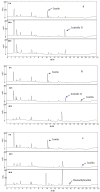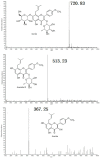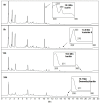Icariin Metabolism by Human Intestinal Microflora
- PMID: 27589718
- PMCID: PMC6273050
- DOI: 10.3390/molecules21091158
Icariin Metabolism by Human Intestinal Microflora
Abstract
Icariin is a major bioactive compound of Epimedii Herba, a traditional oriental medicine exhibiting anti-cancer, anti-inflammatory and anti-osteoporosis activities. Recently, the estrogenic activities of icariin drew significant attention, but the published scientific data seemed not to be so consistent. To provide fundamental information for the study of the icaritin metabolism, the biotransformation of icariin by the human intestinal bacteria is reported for the first time. Together with human intestinal microflora, the three bacteria Streptococcus sp. MRG-ICA-B, Enterococcus sp. MRG-ICA-E, and Blautia sp. MRG-PMF-1 isolated from human intestine were reacted with icariin under anaerobic conditions. The metabolites including icariside II, icaritin, and desmethylicaritin, but not icariside I, were produced. The MRG-ICA-B and E strains hydrolyzed only the glucose moiety of icariin, and icariside II was the only metabolite. However, the MRG-PMF-1 strain metabolized icariin further to desmethylicaritin via icariside II and icaritin. From the results, along with the icariin metabolism by human microflora, it was evident that most icariin is quickly transformed to icariside II before absorption in the human intestine. We propose the pharmacokinetics of icariin should focus on metabolites such as icariside II, icaritin and desmethylicaritin to explain the discrepancy between the in vitro bioassay and pharmacological effects.
Keywords: Epimedium koreanum; biotransformation; desmethylicaritin; human intestinal bacteria; icariin; icariside II; icaritin.
Conflict of interest statement
The authors declare no conflict of interest. The founding sponsors had no role in the design of the study; in the collection, analyses, or interpretation of data; in the writing of the manuscript, and in the decision to publish the results.
Figures







Similar articles
-
Determination of rat urinary metabolites of icariin in vivo and estrogenic activities of its metabolites on MCF-7 cells.Pharmazie. 2005 Feb;60(2):120-5. Pharmazie. 2005. PMID: 15739900
-
Pharmacokinetics of prenylflavonoids and correlations with the dynamics of estrogen action in sera following ingestion of a standardized Epimedium extract.J Pharm Biomed Anal. 2009 Sep 8;50(2):216-23. doi: 10.1016/j.jpba.2009.04.022. Epub 2009 May 3. J Pharm Biomed Anal. 2009. PMID: 19464838
-
Icariside II Preparation from Icariin Separated from Epimedium Herbal Extract Powder by a Special Icariin Glycosidase.J Microbiol Biotechnol. 2024 Dec 28;34(12):2683-2692. doi: 10.4014/jmb.2408.08046. Epub 2024 Oct 24. J Microbiol Biotechnol. 2024. PMID: 39603999 Free PMC article.
-
Icariin and its metabolites regulate lipid metabolism: From effects to molecular mechanisms.Biomed Pharmacother. 2020 Nov;131:110675. doi: 10.1016/j.biopha.2020.110675. Epub 2020 Aug 28. Biomed Pharmacother. 2020. PMID: 32861069 Review.
-
Functions and action mechanisms of flavonoids genistein and icariin in regulating bone remodeling.J Cell Physiol. 2013 Mar;228(3):513-21. doi: 10.1002/jcp.24158. J Cell Physiol. 2013. PMID: 22777826 Review.
Cited by
-
Rubrofusarin as a Dual Protein Tyrosine Phosphate 1B and Human Monoamine Oxidase-A Inhibitor: An in Vitro and in Silico Study.ACS Omega. 2019 Jul 3;4(7):11621-11630. doi: 10.1021/acsomega.9b01433. eCollection 2019 Jul 31. ACS Omega. 2019. PMID: 31460269 Free PMC article.
-
Icariin as a Treatment Proposal in Mammalian Reproduction.Pharmaceuticals (Basel). 2024 Aug 23;17(9):1104. doi: 10.3390/ph17091104. Pharmaceuticals (Basel). 2024. PMID: 39338269 Free PMC article. Review.
-
Dietary Phytoestrogens and Their Metabolites as Epigenetic Modulators with Impact on Human Health.Antioxidants (Basel). 2021 Nov 26;10(12):1893. doi: 10.3390/antiox10121893. Antioxidants (Basel). 2021. PMID: 34942997 Free PMC article. Review.
-
Bioavailability Improvement Strategies for Icariin and Its Derivates: A Review.Int J Mol Sci. 2022 Jul 7;23(14):7519. doi: 10.3390/ijms23147519. Int J Mol Sci. 2022. PMID: 35886867 Free PMC article. Review.
-
Potential roles of gut microbes in biotransformation of natural products: An overview.Front Microbiol. 2022 Sep 29;13:956378. doi: 10.3389/fmicb.2022.956378. eCollection 2022. Front Microbiol. 2022. PMID: 36246222 Free PMC article. Review.
References
-
- Tang W., Eisenbrand G. Handbook of Chinese Medicinal Plants. Wiley-VCH; Weinheim, Germany: 2011.
-
- Wang L., Wang X., Kong L. Automatic authentication and distinction of Epimedium koreanum and Epimedium wushanense with HPLC fingerprint analysis assisted by pattern recognition techniques. Biochem. Syst. Ecol. 2012;40:138–145. doi: 10.1016/j.bse.2011.10.014. - DOI
-
- Kim S.J., Park M.S., Ding T., Wang J., Oh D.H. Biological activities of isolated icariin from Epimedium koreanum Nakai. J. Korean Soc. Food Sci. Nutr. 2011;40:1397–1403. doi: 10.3746/jkfn.2011.40.10.1397. - DOI
MeSH terms
Substances
LinkOut - more resources
Full Text Sources
Other Literature Sources
Miscellaneous

